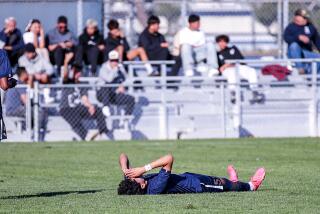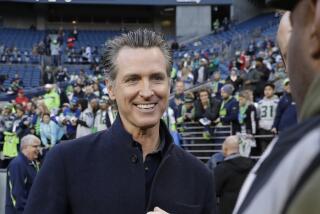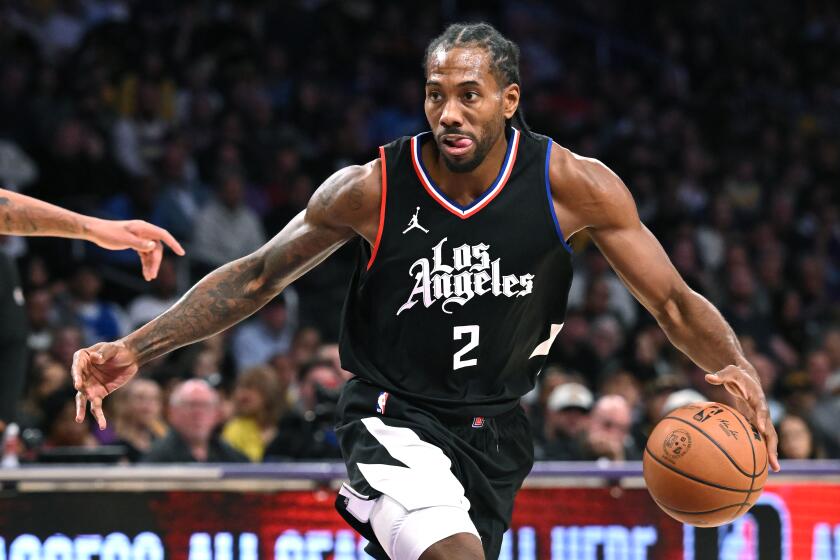X Games athletes could learn concussion risks from NFL players
Part 1 of a two-part series on concussions in action sports. Part 2 Sunday will focus on 40-year-old BMX rider Kevin Robinson.
Action sports superstar Travis Pastrana tells a story about his uncle, Alan Pastrana, who suffered a major concussion near the end of his two-year tenure as a quarterback for the Denver Broncos in the late 1960s. He was 26 when his NFL career ended.
“He went from a very tough, tough guy to super emotional, super sensitive, the most ‘huggy’ man you’d ever see,” Travis says.
Pastrana shares that anecdote about his uncle to underscore the severity of traumatic head injuries — and how they can alter a life.
Travis Pastrana, who’ll compete in the RallyCross race this Sunday at the X Games in Los Angeles, doesn’t just know about concussions because of his uncle. Travis estimates that he’s suffered more than 50 concussions in his own action sports career.
“I’ve had concussions literally on a weekly basis,” he says, “and I’m still as normal as possible.”
Still, Travis, who began riding motocross at 4 years old and is now 28, has had to overcome numerous concussion-related effects: memory lapses, vision loss, weeks of nausea and months of fatigue.
“I had to take a year off at one point,” he says. “This was back in 2001. I had a couple in a row before I understood. I was tired and fatigued and I kept going out before I was ready.”
Though traumatic head injuries are more often associated with football and hockey, they are an issue that many action sports athletes must also face.
But how concussions are perceived around action sports — whose pinnacle event is the X Games — is an altogether different issue.
Interviews with about a dozen athletes, doctors who specialize in traumatic head injuries, helmet manufacturers and others close to action sports reveal wildly varying levels of concern about concussions.
Many athletes say they consider concussions as simply part of the sport — so much so that, BMX pioneer Mat Hoffman says, “It’s not really talked about.”
Says three-time X Games gold medalist skateboarder Ryan Sheckler: “I don’t think about hitting my head on the ground ever and neither does anybody I compete with.” He added, “You don’t think about injury in our sport. If you think you’re going to fall, don’t skate.”
Sheckler, 22, says he has had three or four concussions.
Travis Pastrana is well aware of the signs to look for from a concussion. “When your brain is not right, you get tired and you get nauseous and your body will shut itself down,” he says.
Yet, Pastrana says, when doctors ask how an athlete is doing, the response is often dishonest. “You can be about to throw up and so tired you can’t even keep your eyes open and you’re like, ‘I’m fine, coach. Put me in.’”
Dr. Neha Raukar, a physician in both emergency medicine and primary care sports medicine at Rhode Island Hospital, is used to hearing that kind of deception from action sports athletes.
“Nobody listens to you, I’ve learned,” says Raukar, who specializes in traumatic brain injuries and has spent five years as a sideline physician for the Dew Tour and UCI, the international BMX team.
“It used to be that the football players were the hallmark of concussion and violence in sports,” she says. Action sports athletes “are the ones who should be the benchmark now for bad head injuries. I don’t think people really get that. I think they look at football players, but they don’t look at [action sports] athletes.”
Dr. Ruben Echemendia has studied head injuries for decades and says he often sees action sports athletes who suffer a blow to the head and then return to competition without being evaluated.
“The action sports athletes, I think, are where some of the football and hockey athletes were 10 years ago,” Echemendia says, “where they see concussions as being part of the game, something that needs to be played through … as opposed to looking at them and say, ‘OK, we need to manage this.’”
Multiple medical experts say the first step for athletes in any sport after suffering a head injury is to immediately remove themselves from competition so they can be examined.
The X Games’ policy calls for athletes who are suspected of suffering concussions to be removed from competition until they are evaluated by a trained medical professional.
At the X Games, there are 15 athletic trainers, five physical therapists and six physicians on call, plus two EMTs at each event, a spokesman said. Dr. David Chao, the X Games medical staff’s lead physician, said all of the physicians and athletic trainers are trained in recognizing the signs and symptoms of a concussion.
To some, the issue of head injuries in action sports boils down to wearing a helmet.
“I still go to skate parks and see kids riding without helmets,” said BMX rider Anthony Napolitan. “I just can’t believe it. You see when a rider goes down, everybody just makes a big fuss about it … [but] just wear a freaking helmet.”
Among helmet manufacturers, one key issue is that some action sports athletes will buy the wrong helmet — that is, a BMX rider will buy a helmet structurally designed for skateboarders, for instance. Another issue is the idea of “fashion over function” — buying a helmet for its looks rather than its functionality.
Yet, helmets are not a cure-all, Echemendia says.
Modern helmets are designed to protect against skull fracture but not to absorb force so that it doesn’t fully reach the brain, Echemendia says. “There’s really no data to suggest that in actual use, helmets reduce the number of concussions,” he says.
There is also limited information about concussions, he says, because researchers only began taking the issue seriously in the last 15 years.
Pastrana says that after doing his own research he’s found that an athlete can continue a career even after suffering multiple concussions, because he has done it.
But Pastrana adds that he also has a friend who suffered his first concussion while skateboarding, seemed fine, later had a seizure and now is “pretty much brain dead.”
“For me, I’m on the side of, you know what you’re getting into, just understand it better and know what the signs are,” Pastrana says. “You can make that call for yourself.”
twitter.com/BaxterHolmes
More to Read
Get our high school sports newsletter
Prep Rally is devoted to the SoCal high school sports experience, bringing you scores, stories and a behind-the-scenes look at what makes prep sports so popular.
You may occasionally receive promotional content from the Los Angeles Times.






